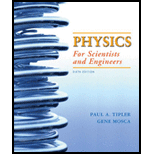
Concept explainers
(a)
Whether the statement is true or false.
(a)
Explanation of Solution
Introduction:
Simple harmonic oscillator is any system which when displaced from its equilibrium position, exhibits a restoring force where restoring force is directly proportional to the displacement.
The time period in the simple harmonic oscillator is the time taken to complete full oscillation.
Write the expression for the time period of the simple harmonic oscillator.
Here,
Conclusion:
The time period of a simple harmonic oscillator does not depend on the amplitude. Thus, the statement is not correct.
(b)
Whether the statement is true or false.
(b)
Explanation of Solution
Write the expression for the time period of the simple harmonic oscillator.
The frequency in the simple harmonic oscillator is inversely proportional to the time period.
Here,
Substitute
Thus, the frequency of the simple harmonic oscillator does not depend on amplitude, it depends on two factors one is mass and the other is force constant.
Conclusion:
The frequency of the simple harmonic oscillator does not depend on the amplitude. Thus, the statement is correct.
(c)
Whether the statement is true or false.
(c)
Explanation of Solution
The condition for the simple harmonic oscillator is that force should be directly proportional to the displacement and the displaced object tends to move in its equilibrium position. The restoring force always acts in the direction opposite to the particle displacement. For any system to be simple harmonic the acceleration of the particle is in the opposite direction from its equilibrium position and acceleration should be proportional to the displacement from the equilibrium position.
Conclusion:
The net force in the particle is one-dimensional motion which is directly proportional to the displacement made by the particle from its equilibrium position. Thus, the statement is correct.
Want to see more full solutions like this?
Chapter 14 Solutions
Physics for Scientists and Engineers
- Can this analogy of SHM to circular motion be carried out with an object oscillating on a spring vertically hung from the ceiling? Why or why not? If given the choice, would you prefer to use a sine function or a cosine function to model the motion?arrow_forwardShow that, if a driven oscillator is only lightly damped and driven near resonance, the Q of the system is approximately Q2(TotalenergyEnergylossduringoneperiod)arrow_forwardCheck Your Understanding Identify one way you could decrease the maximum velocity of a simple harmonic oscillator.arrow_forward
- Find the frequency of a tuning fork that takes 2.50103 s to complete one oscillation.arrow_forwardCheck Your Understanding Why are completely undamped harmonic oscillators so rare?arrow_forwardShow that the time rate of change of mechanical energy for a damped, undriven oscillator is given by dE/dt = bv2 and hence is always negative. To do so, differentiate the expression for the mechanical energy of an oscillator, E=12mv2+12kx2, and use Equation 12.28.arrow_forward
- Refer to the problem of the two coupled oscillators discussed in Section 12.2. Show that the total energy of the system is constant. (Calculate the kinetic energy of each of the particles and the potential energy stored in each of the three springs, and sum the results.) Notice that the kinetic and potential energy terms that have 12 as a coefficient depend on C1 and 2 but not on C2 or 2. Why is such a result to be expected?arrow_forwardDo you think there is any harmonic motion in the physical world that is not damped harmonic motion? Try to make a list of five examples of undamped harmonic motion and damped harmonic motion. Which list was easier to make?arrow_forwardPlot a velocity resonance curve for a driven, damped oscillator with Q = 6, and show that the full width of the curve between the points corresponding to is approximately equal to ω0/6.arrow_forward
- Prove that using x(t)=Asin(t+) will produce the same results for the period for the oscillations of a mass and a spring. Why do you think the cosine function was chosen?arrow_forwardMost harmonic oscillators are damped and, if undriven, eventually come to a stop. Why?arrow_forwardAllow the motion in the preceding problem to take place in a resisting medium. After oscillating for 10 s, the maximum amplitude decreases to half the initial value. Calculate (a) the damping parameter β, (b) the frequency υ1 (compare with the undamped frequency υ0), and (c) the decrement of the motion.arrow_forward
 University Physics Volume 1PhysicsISBN:9781938168277Author:William Moebs, Samuel J. Ling, Jeff SannyPublisher:OpenStax - Rice University
University Physics Volume 1PhysicsISBN:9781938168277Author:William Moebs, Samuel J. Ling, Jeff SannyPublisher:OpenStax - Rice University Classical Dynamics of Particles and SystemsPhysicsISBN:9780534408961Author:Stephen T. Thornton, Jerry B. MarionPublisher:Cengage Learning
Classical Dynamics of Particles and SystemsPhysicsISBN:9780534408961Author:Stephen T. Thornton, Jerry B. MarionPublisher:Cengage Learning Principles of Physics: A Calculus-Based TextPhysicsISBN:9781133104261Author:Raymond A. Serway, John W. JewettPublisher:Cengage Learning
Principles of Physics: A Calculus-Based TextPhysicsISBN:9781133104261Author:Raymond A. Serway, John W. JewettPublisher:Cengage Learning Physics for Scientists and Engineers: Foundations...PhysicsISBN:9781133939146Author:Katz, Debora M.Publisher:Cengage Learning
Physics for Scientists and Engineers: Foundations...PhysicsISBN:9781133939146Author:Katz, Debora M.Publisher:Cengage Learning



